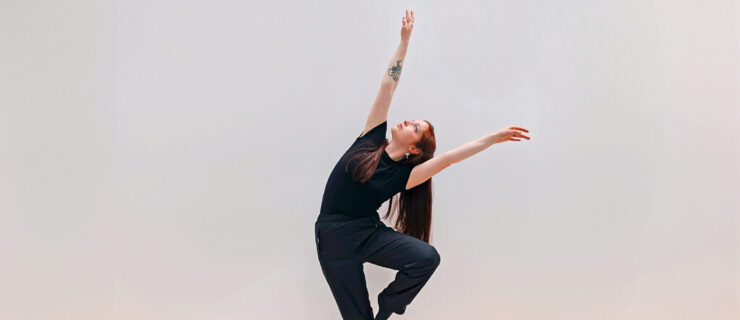Dancer, Heal Thyself
For most dancers, the joys of dancing are coupled with inevitable aches and pains. You’ve probably heard about a bunch of alternative healing therapies, but how do you tell them apart and choose which one is right for you? Each of the therapies described here is meant to treat musculoskeletal injuries, but they’re also great for preventative, ongoing care. Keep in mind that if you’ve broken a bone or struggle with a serious injury or illness, you should head straight to your doctor! Finding the right therapy for your body might take time, so be patient and have fun with the process.
MASSAGE THERAPY
What Is It?
The practitioner massages soft tissues (muscles and tendons) in order to increase the body’s blood flow and circulation. According to massage therapist Caroline O’Connor, “Massage enhances movement and flexibility in the joints and muscles, and promotes the release of toxins from the body.” Two common forms of massage are Swedish and Shiatsu.
What to Expect:
While receiving a Swedish massage, you lie beneath a sheet on a table. A therapist uses his or her “palms, thumbs, elbows and forearms to deliver strokes,” O’Connor explains, which might feel long and flowing (covering the length of your muscle), or like focused pressure on a specific muscle.
Shiatsu massage
originated in the practice of acupressure, an Asian therapeutic technique based on the belief that there are energy centers in the body called meridians. Meridians correspond to various muscles and organs. During an appointment, you lie on a futon-like mat or on the floor. The therapist “taps, squeezes and rubs energy centers to release blocked energy,” O’Connor says. Practitioners may ask you to breathe with the pressure and provide verbal feedback.
Swedish
Pro:
For many people, the experience of getting a Swedish massage is very relaxing.
Con:
If being unclothed in front of other people is uncomfortable for you, this may feel too intimate.
Shiatsu
Pro:
Being so involved in the process can increase your body awareness.
Con:
Shiatsu’s effectiveness relies on your feedback and body awareness. If you want to tune out, this is not for you.
CRANIOSACRAL THERAPY
What Is It?
Craniosacral therapists believe that we all have fluid in the spine that moves at a rhythm unique to each person; this rhythm must be maintained for the body to move with ease. Injuries cause the fluid to become restricted, so a therapist works to balance this flow by very gently touching around the base of the head and along the spine towards the sacrum.
What to Expect:
During craniosacral therapy, you lie on your back and a practitioner massages areas around the base of your skull and sacrum very lightly. You may feel very little, but the hand pressure is gently encouraging spinal fluid to move. Afterwards, you may feel light-headed, deeply relaxed or more aligned in your spine.
Pro:
Gentle and noninvasive, craniosacral therapy provides an opportunity to connect with a complex and very subtle system in your body.
Con:
The minimal level of sensation may be frustrating if you like deep tissue massage. It also requires mental focus.
ACUPUNCTURE
What Is It?
Like Shiatsu massage, acupuncture focuses on a system of meridians, or energy centers. Practitioners insert extremely fine needles very shallowly into specific meridians on the body. This allows energy to flow, relieves tension and aids in healing muscle soreness.
What to Expect:
The acupuncturist takes a full medical history (from your sleep patterns to the regularity of your period). Once you’re lying down, he inserts needles into the skin near the injured area—but don’t be surprised if needles are also inserted elsewhere, like in your head. These points correspond to various energy channels. You may feel a prick or muscle surge when the needle is inserted—this means the energy is flowing. You then lie still for 30 minutes or so while the needles do their thing. It’s normal to fall asleep or feel relaxed during and after a session.
Pro:
Acupuncturists often offer holistic counseling about many areas of your life, including your diet, sleep, exercise and mental health.
Con:
If needles make you queasy, acupuncture probably isn’t your thing! Also, the sensation can be quite subtle, so if you like deep tissue work, this isn’t for you.
CHIROPRACTIC THERAPY
What Is It?
Chiropractic care deals with the spine’s relationship to the rest of the body. Chiropractors apply controlled manual pressure to the spinal vertebrae. These are called adjustments and they release stress and tension in the body.
What to Expect:
You lie down on a table and the chiropractor adjusts your spine. You’ll hear a series of popping sounds—this is the release of blocked spinal fluid. The release may help you feel more open, aligned and limber in your movements. Chiropractors often ask for a health history (including neurological and orthopedic information) before providing treatment, and they may take X-rays, do massage therapy and suggest strengthening exercises.
Pro:
Many insurance companies cover the cost. For some people, it provides immediate relief.
Con:
The popping sound can be overwhelming and the adjustments may feel aggressive to some people. Treatments also involve multiple visits.
CUPPING THERAPY
What Is It?
During cupping therapy, a small glass is heated and the rim is placed face-down on the injured, blocked area of the body. The pressure beneath the cup creates suction that pulls skin up, around and under the cup. Chinese medicine doctor Thomas Droge says, “This draws heat and ‘dead’ blood out of the tissue, freeing restrictions and increasing blood flow and function to the area. This results in better movement and greater breathing capacity.”
What to Expect:
You lie down on a table and the practitioner places the cups directly onto your skin. “It feels like a massage therapist is giving you a very deep tissue massage,” Droge explains. Sometimes the cups stay stationary and other times they’re moved in a rhythmic manner.
Pro:
Immediate pain relief and increased breathing capacity.
Con:
This aggressive treatment is not for everyone and it shouldn’t be done frequently. It leaves dark round marks on the skin for a few days, so if you’re performing in a backless costume anytime soon, try something else!



